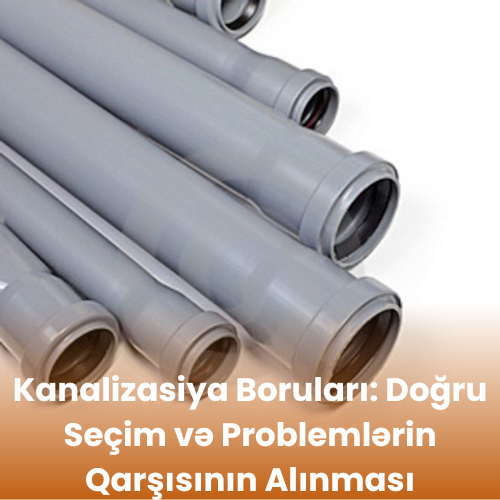Sewer Pipes: Choosing the Right One and Preventing Problems

The Importance of Sewer Pipes
Sewer pipes are essential infrastructure elements that ensure the safe and efficient discharge of wastewater. Their proper installation and operation play a crucial role in both human health and environmental protection.
Main Benefits of Sewer Pipes
1. Sanitary Hygiene and Disease Prevention
Sewer systems direct wastewater to treatment plants, preventing the spread of bacteria and diseases.
2. Environmental Protection
They prevent the contamination of natural water sources and help maintain the ecological balance of soil and water bodies.
3. Comfortable and Safe Living Environment
Modern sewer systems contribute to the creation of a comfortable and healthy living environment in urban and rural areas.
4. Infrastructure Sustainability
Strong and high-quality pipes ensure the longevity of urban infrastructure and reduce maintenance costs.
Types of Sewer Pipes
Sewer pipes are categorized based on their application, material, and structure. The correct selection and installation of these pipes ensure the long-term and efficient operation of the sewer system.
1. Sewer Pipes by Application
-
Indoor sewer pipes – Used for wastewater disposal inside buildings.
-
Outdoor sewer pipes – Used to transport wastewater from buildings to the municipal sewer network.
-
Stormwater pipes – Designed for draining rainwater and melted snow.
2. Sewer Pipes by Material
-
Plastic (PVC and PPR) pipes – Lightweight, rust-resistant, and durable. One of the most commonly used types.
-
Cast iron pipes – Strong and durable, but prone to rust over time.
-
Concrete pipes – Used in large-diameter sewer systems, heavy and sturdy.
-
Ceramic pipes – Resistant to chemicals and mainly used in industrial facilities.
3. Sewer Pipes by Structure
-
Smooth inner-surface pipes – Provide better flow and prevent blockages.
-
Thick-walled pipes – Resistant to high pressure and mechanical impact.
-
Corrugated pipes – Flexible and suitable for underground installations.
Choosing the Right Sewer Pipe
To ensure the long-lasting and efficient operation of the sewer system, selecting the appropriate pipes is crucial. Several key factors should be considered when choosing pipes: application, material, diameter, and environmental conditions.
1. Selection Based on Application
-
For indoor sewer systems – PVC or PPR pipes are preferable as they are lightweight and rust-resistant.
-
For outdoor sewer systems – Concrete, corrugated, or high-pressure-resistant plastic pipes should be chosen.
-
For industrial and chemical waste – Ceramic or special plastic pipes resistant to chemicals are recommended.
2. Material Selection
-
PVC pipes – The most common, lightweight, affordable, and easy to install.
-
Concrete pipes – Durable and resistant to high pressure, mainly used in large sewer systems.
-
Cast iron pipes – Used in high-strength applications, but less common due to susceptibility to rust.
3. Pipe Diameter
-
For household sewer systems – 100-150 mm diameter pipes are sufficient.
-
For municipal sewer networks – Larger diameter pipes (200 mm or more) are required.
4. Environmental and Climatic Conditions
-
Pipes must be resistant to freezing in cold climates.
-
Soil and water levels should be considered, as some pipes need to withstand high humidity.
Sewer Pipe Installation
Proper installation of sewer pipes is essential for the long-lasting and efficient operation of the system. Technical regulations and standards must be followed during installation.
1. Preparation Work
-
A project plan should be created, and the route of the pipes should be determined.
-
The type and diameter of the pipes should match the wastewater volume.
-
The depth and slope angle should be accurately calculated during excavation.
2. Laying the Pipes
-
A sand layer should be placed beneath the pipes to create a stable base.
-
Proper connections should be ensured to prevent leakage.
-
Pipes should be positioned at a specified angle to facilitate natural water flow.
3. Sealing and Safety Measures
-
Pipe joints should be reinforced with special rubber rings or adhesives.
-
Outdoor sewer pipes should be insulated to protect against freezing.
-
Inspection manholes should be installed to prevent blockages.
4. Testing and Commissioning
-
After installation, the system should be filled with water for a leakage test.
-
If necessary, adjustments should be made to certain pipe sections.
-
The sewer system should only be put into operation after a thorough inspection.
Frequently Asked Questions About Sewer Pipes
1. What types of sewer pipes exist?
Sewer pipes are categorized by application, material, and structure. The main types are:
-
Indoor and outdoor sewer pipes
-
Plastic (PVC, PPR), concrete, cast iron, and ceramic pipes
-
Smooth and corrugated pipes
2. Which pipe material is the most durable?
PVC and concrete pipes are the most durable. PVC pipes do not rust and are easy to install, while concrete pipes withstand high pressure.
3. How should the diameter of sewer pipes be chosen?
-
For household sewer systems – 100-150 mm
-
For municipal sewer networks – 200 mm or more
-
For stormwater drainage – 150-300 mm
4. How should sewer pipes be installed?
Pipes must be installed at the correct angle, sealed properly, and protected from freezing.
5. How can sewer pipe blockages be prevented?
-
Large waste and grease should not be disposed of in the pipes.
-
Regular maintenance and cleaning should be performed.
-
Filters and drainage systems should be installed.
6. How can outdoor sewer pipes be protected from freezing?
Pipes should be buried at the appropriate depth and insulated with protective materials.
By addressing these questions, you can ensure a long-lasting and trouble-free sewer system.
